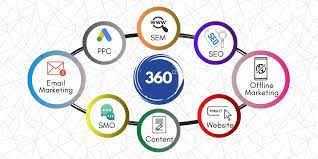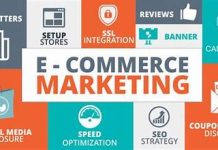If you want to understand your clients’ habits, wants, and requirements, you need to leverage every bit of information at your disposal as a brand.
Moreover, you can potentially reach a far larger audience with the correct data and a well-executed digital marketing campaign.
A 360-degree digital marketing approach might help top digital marketing agencies London learn more about their customers’ purchasing paths. Read on to find out every detail regarding 360-degree advertising.
Definition: 360 Marketing
A 360 marketing strategy is an integrated plan that targets numerous platforms and channels to reach the target demographic.
One of the goals of 360-degree marketing is to raise brand awareness. A complete marketing strategy can raise brand awareness and encourage potential customers to get in touch. Inbound advertising describes this method. It’s the clients who initiate interaction with your business.
However, if you want to implement a 360-degree marketing strategy, you’ll need material to disseminate and, more importantly, strong reasons to back up your claims. You’ll need to highlight what sets you apart from the competition.
Step-by-Step Guide to Creating a 360 Marketing Strategy That Actually Works:
While a 360-degree marketing strategy allows you to potentially utilise any number of channels, practical considerations such as time and money may limit you to a more manageable number.
It is also unnecessary to use every possible channel. Focusing on the specific medium or platforms where the bulk of your intended audience spends their time will yield the best results.
1. Determine Your Purpose and Plan
Determine your campaign’s goals after you have an idea of the channels you should pursue. Plan out how you’ll organise your strategy depending on whether you want to raise awareness of your brand, introduce a new product, or reposition your company.
Consider the channels of promotion you identified via your study of your target audience in light of the goal you set for yourself. Make better use of your time and money by narrowing your focus using this tool. Set objectives to work for and base your efforts on.
2. Map Out Your Customer Journey and Touchpoints
Content, platforms, and approach will ultimately change as you move from the top of the funnel to the bottom.
You need to find your audience and understand when they will most likely be online. You also need to know your clientele inside and out before you can achieve this.
Analyse the customer experience from the point of first exposure to your brand all the way through to the point at which satisfied customers may become brand promoters.
You need to know how to reach your clients at every stage of the buying experience, and those stages will each have a different set of touchpoints.
For instance, customers will be searching for answers to their problems during the contemplation phase of the buyer’s journey. The content you plan to give to your customers must be available on the medium where they are most likely to do further research.
3. Know Where Your Target Audience Is
Find out who you want to reach and where they hang out before you dive too deeply into your marketing campaign’s strategy development.
It’s important to zero down on just the right channels so that you may reach your intended audience.
Spend some time learning about your ideal clients and the channels via which they are most likely to read and react to your marketing materials. Information is available via Google Analytics measurements and the data collected from social media networks.
In order to develop a buyer persona, you should look for patterns that provide information about your consumers’ demographics, preferred platforms, interests, and other characteristics. Polls and surveys can provide further insight into your target demographic.
4. Use Pay-Per-Click Advertising for Quick Results
Are you aware that 41% of all clicks on search engine results pages go to the top three paid advertising spots?
The return on investment from pay-per-click (PPC) advertising can be as fast as just after you launch the campaign. Text, display, social media, retargeting, and Google Shopping advertising are all part of pay-per-click marketing.
While pay-per-click advertising (PPC) might yield immediate results, it also has the potential to swiftly deplete your marketing budget. You should never rely just on paid advertising; rather, it should be one component of a comprehensive marketing strategy that also makes use of other methods.
Paid search engine marketing can help raise your brand’s visibility and revenues while you wait for search engine optimisation and social media marketing to gain traction.But the traffic flowing through the ads isonly as good as the infrastructure on the other end of a link,so make sure the link takes people to the appropriate landing page where they can purchase or schedule an appointment.
Use split-testing software to find out which of the two ad versions performs better. To see what works best, test out different variants of copy, designs, and calls to action.
Using remarketing is an effective strategy for maximising the ROI of pay-per-click (PPC) advertising campaigns. If you turn this on, users who saw your site but didn’t buy anything will be shown your advertising again, increasing the likelihood that they’ll convert.
5. Monitor Your Results and Track Conversions
In order to complete your 360-degree marketing strategy, you must keep an eye on the outcomes and record the quantity of conversions as well as their sources.
Metrics for some channels can be checked as frequently as once every day, allowing for prompt alterations to be made.
Checking back in on this information on a frequent basis will let you know if your assumptions about your target audience were correct.
You should remember that you need to maintain some degree of adaptability, as the requirements of your target audience may shift in response to shifting fashion, lifestyle, etc.
Summarising it up!
As you may have noticed by now, your 360-degree marketing approach is based on research into your target demographic. You can’t predict what to do next to guarantee success until you conduct audience research.
Once you have a firm grasp of your target demographic, you can employ a multifaceted marketing strategy to propel your business to the next level, including pay-per-click (PPC), social media, and even personal interaction. Lastly, your content must be spot-on if you want your 360-degree marketing plan to succeed.













